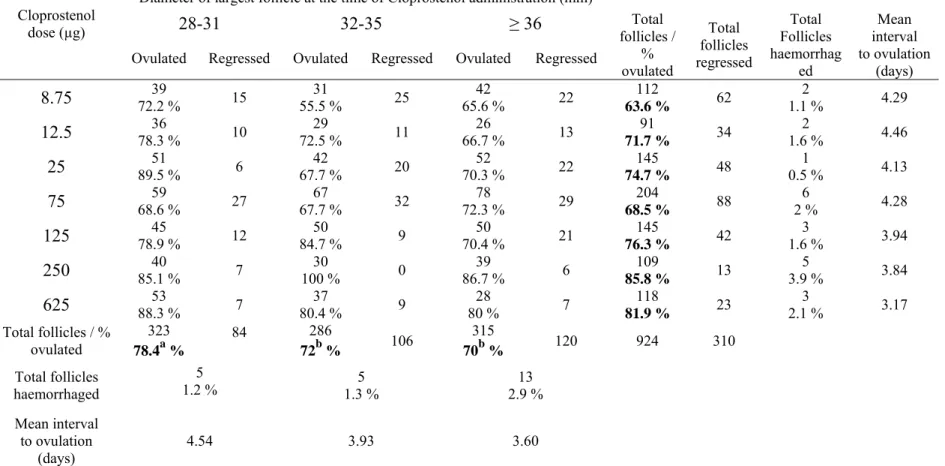Effect of dose of cloprostenol on the interval to ovulation in the diestrous mare : a retrospective study/ J R Newcombe, W Jöchle and J Cuervo Arango
Texto completo
(2) 2. INTRODUCTION Prostaglandin (PGF) and its analogues are used largely as a luteolytic drugs in animal reproduction, especially in horses and cattle. There is a wide range of commercial prostanoids available for use in practice. Among them, Cloprostenol (Estrumate®1), originally developed for cattle, is commonly used in equine reproduction. In the mare, PGF and its analogues are firmly established luteolysins for the shortening of individual oestrus cycles, the treatment of mares with persistent diestrus and the interruption of early gestation. During the first three to four days post ovulation, the corpus luteum (CL) is thought to be refractory to the recommended dose rate of PGF (9 mg / kg) and its analogues (1 ml of Estrumate, 250 µg Cloprostenol)1,2 so that conventionally PGF is not administered until the CL is at least 5 days old. Normally at this stage any developing follicles are less than 20 mm in diameter and may take up to 12 days to develop and ovulate (unpublished data). Not infrequently however, by 5 or 6 days after ovulation, a new diestrus follicle of > 30 mm has developed and following lysis of the CL, the inhibition of any LH surge by high progesterone concentrations is removed. The result is that the follicle may ovulate soon after PGF administration, depending on its diameter and degree of maturity. Although PGF is best known for its luteolytic effect, it also causes immediate release of LH 3 resulting in induction of ovulation in numerous species 4,5,6,7 including equine.8,9,10 There is clinical and scientific evidence that administration of a PGF analogue may induce oestrus and / or ovulation even in mares with baseline plasma progesterone concentration without a preceding luteolysis.11,12,13. Savage and Liptrap (1987)10 induced ovulation by 48h after treatment with fenprostalene in 81 % of treated mares during oestrus. In that study fenprostalene was chosen among other PGF analogues because of it long acting effect (half-life of 24 h). It has been shown that the ovulatory effect of PGF is not only locally at the follicular level but also at the neurocrine hypothalamus-hypophysis axis in the CNS.14 That study showed an immediate increase of FSH and LH in peripheral blood and a later rise of GnRH after administration of luprostiol, a PGF analogue in transitional mares resulting in continued elevation of blood concentrations of FSH and LH for several hours.. 1. Estrumate, Intervet, Cambridge, UK..
(3) 3 This early evidence supports the ability of PGF to hasten ovulation, however to date there has been no study on the effect of PGF dose on the time to induce ovulation. After many years of practical experience on use of different dose rates of Cloprostenol to induce luteolysis and ovulation, it was decided to collate and analyse existing data to characterize the effect of dose-rate of Cloprostenol on the interval from treatment to ovulation. The aims of this study were to investigate the relationship (a) between dose-rate of Cloprostenol administered in diestrus and the interval to ovulation and b) between the diameter of the dominant follicle at the time of PGF treatment and interval to ovulation. The hypothesis tested was that dose rate of Cloprostenol would have an effect on the interval from treatment to ovulation and that this effect would increase with dose. It was also hypothesized that the interval to ovulation would be shorter when treatment is given to mares with larger follicles.. MATERIALS AND METHODS. Animals A total of 1234 estrous cycles were analysed in the study over a period of 10 years. The mares treated were either visiting a veterinary fertility clinic or commercial breeding farms where they were ultrasonographically examined at either intervals of 6 to 24 h (n = 230). (clinic) or every two days (n = 1004) (farms). The mares were mostly. Thoroughbred (farms) with small numbers of TB crossbreds, Warmbloods and Irish Draughts (clinic).. Cloprostenol All treated mares were in diestrus (defined by a tight, tonic external cervix, the presence of an ultrasonically visible corpus luteum and presence of a uterine echotexture characteristic of a progestational influence15 at both known and unknown periods from ovulation. They were given Cloprostenol (250 µg Cloprostenol / ml Estrumate) subcutaneously at dose rates of 8.75 (n = 174), 12.5 (n = 125), 25 (n = 193), 75 (n = 292), 125 (n = 187), 250 (n = 122) and 625 (n = 141) µg. irrespective of body weight. Doses of less than 75 µg were measured by administration of a x 20 dilution with sterile.
(4) 4 water for injection. Dose rate is expressed in µg / mare and not body weight. Individual weights were unknown but almost all mares would have been between 350 and 600 kg. Dose rate varied as part of ongoing trials of Cloprostenol, the doses below 125 µg were used only in mares known to be in late or prolonged diestrus (>10 days post ovulation) or following pregnancy loss since it was known that the dose response rate is highly dependent on the age of the most recent corpus luteum. Doses of 250 µg were mostly used in mares with a CL aged 6 to 7 days and the highest dose was always used in mares known to have a CL aged ≤ 5 days.. Follicular diameter Diameter of the largest follicle at the time of Cloprostenol administration was recorded for each mare. Only data from mares with a follicle of ≥ 28 mm present at the time of treatment were included in the study. Based on follicular diameter, for data analysis mares were included in one of three groups: 1) follicles from 28 to 31 mm; 2) follicles from 32 to 35 mm and 3) follicles > 36 mm. Follicular diameter was obtained ultrasonographically from the average of 2 linear measurements of the antrum taken at right angles when the image of the follicle was frozen at its maximum size. Subjectivity in measurements was minimized as the same person using the electronic calipers made all the recordings.. Interval from Cloprostenol treatment to ovulation After Cloprostenol adminstration, mares were followed with ultrasound every 6 to 24 h (mares in the clinic) or every 48 h in mares at the commercial farms. The largest follicle at the time of PGF administration was followed for each mare and classified as either a: -. Regressing follicle: when the diameter of the follicle became smaller or remained static and was overridden by the development of a new ovulatory follicle. -. Haemorrhagic follicle: when the follicle filled with blood (as evidenced by ultrasonographic appearance of floating hyperechoic specks, kept its shape and remained or increased its diameter but did not subsequently collapse). For data analysis this type of follicle was regarded as regressing.. - Ovulatory follicle: when the dominant follicle at the time of Cloprostenol treatment was followed by an ovulation. Ovulation was detected as per rectal palpation and ultrasonographic absence of the previously follicle recorded and presence of a hypoechoic developing to hyperechoic area within the same ovary. In mares.
(5) 5 examined every 48 h, the day of ovulation was estimated by assessing the morphology and echodensity of the ovulatory area 16,17. Intervals from Cloprostenol treatment to ovulation are expressed in days (± 12 h). For data analysis on the effect of Cloprostenol dose rate and follicular diameter at the time of treatment on interval to ovulation, only mares with ovulating follicles were used. Mares in which there was only a partial response, including those which ovulated during diestrus, and mares which showed no clinical response within 6 days of treatment, were excluded from the data. The interval from treatment to ovulation ranged from 1 to 12 days.. Statistical analysis All numerical data was obtained from intervals to ovulation from Cloprostenol treatment, measured in days. Data was entered in the statistical software (Minitab 15 ®) and analysed using a general linear model of analysis of variance. The model included dose of Cloprostenol (as treatment) (8.75, 12.5, 25, 75, 125, 250 and 625 µg) and follicular diameter of the dominant follicle (as blocks) at the time of Cloprostenol treatment (28-31, 32-35 and ≥ 36 mm). The model’s response was observations from intervals to ovulation (measured in days). Tukey’s comparison test was used to test any difference among doses and follicular diameters. Chi-squared analysis was used to determine associations between Cloprostenol dose rate and percentage of ovulating / regressing follicles as well as between follicular diameter and percentage of ovulating / regressing follicles. Linear regression was used to determine the relationship cause-effect between dose of Cloprostenol and interval to ovulation as well as between follicular diameter and interval to ovulation. Interval from Cloprostenol treatment to ovulation is expressed as mean ± S.E.M.. RESULTS There was a significant effect of Cloprostenol dose on interval to ovulation (P = 0.000). Dose rate effect on interval to ovulation was only significant between the largest dose (625 µg, with a mean interval to ovulation of 3.2 ± 0.14 days) and second largest (250.
(6) 6 µg, 3.8 ± 0.15 days) (P = 0.005) and the rest of doses (P = 0.0000) (3.9 ± 0.13, 4.3 ± 0.1, 4.1 ± 25, 4.5 ± 0.12 and 4.3 ± 0.13 days respectively). There was no significant difference between the Cloprostenol doses of 8.75, 12.5, 25, 75, 125 and 250 µg (P > 0.05). When 625 µg of Cloprostenol was used, interval to ovulation was shortest regardless of follicular diameter. Fig. 1 shows the box plot of medians and means of intervals to ovulation for each dose group. The linear regression showed a negative effect of Cloprostenol dose on interval to ovulation (P = 0.000) with larger doses inducing shorter intervals to ovulation. Follicles of ≥ 36 mm took less time to ovulate than those of 32-35 mm (P = 0.005) and those of 28-31 mm (P = 0.0000) (Fig. 2). Similarly, medium size follicles (32-35 mm) ovulated significantly (P = 0.0000) sooner than small follicles (28-31mm). Within each follicle-diameter group, interval to ovulation was shortest when follicles were induced using the largest dose of Cloprostenol as compared with the rest of doses (significance of P = 0.01, P = 0.000 and P = 0.000 for follicle-diameter groups of 28-31, 32-35 and ≥ 36 mm respectively). For mares with follicles ≥ 36 mm, 250 µg of Cloprostenol also induced ovulation significantly faster than 8.75, 12.5, 25 and 75 µg (P < 0.05) but not faster than 125 µg (P > 0.05). Distribution of intervals to ovulation for each Cloprostenol dose within each follicular-diameter group is shown in Fig. 3. For each Cloprostenol dose group there was a negative relationship between interval to ovulation and follicular diameter (Fig. 4). This relationship was significant for all dosegroups (P < 0.002) but for 25 µg group (P > 0.05). An unexpected finding was that Cloprostenol dose and follicular diameter at the time of treatment were associated with the incidence of dominant follicles undergoing regression. This association was significant at P = 0.000 (dose rate) and P = 0.038 (follicular diameter). The highest incidence of regressing follicles (34.4 %) occurred when mares were treated with 8.75 µg, whereas the lowest incidence was found when 250 and 625 µg of Cloprostenol were used (14.2 % and 18.1 % respectively) regardless follicular diameter. Larger follicles at the time of prostaglandin administration were more likely to regress (30 %, 28 % and 21.6 % for follicles of ≥ 36, 32-35 and 28-31 mm respectively) (Table 1). The overall incidence of haemorrhagic follicles was 1.9 %. The Cloprostenol dose groups with highest incidence of haemorrhagic follicles were 250 and 625 µg with 3.9 % and 2.1 % respectively. Although the incidence was greater when higher doses were used, this association was not significant (P > 0.05). The overall incidence of regressing,.
(7) 7 ovulating and haemorrhagic follicles for each dose and follicular diameter group are shown in Table 1.. DISCUSSION The present study is the first to show a dose rate effect of a widely used PGF analogue, Cloprostenol, on the interval from prostaglandin treatment to ovulation. This is in agreement with the observations using the PGF analogue prostalene in diestrous mares with follicles of > 30 mm at treatment.18 The results of this work provide evidence of the ability of Cloprostenol to hasten maturation and time to ovulation of follicles in mares in diestrus in addition to lysis of the CL. It is also shown to be dose-dependant. This effect was highly influenced by diameter of the largest diestrus follicle at the time of treatment, with larger follicles ovulating earlier than smaller. The effect of dose and follicular diameter was synergistic and for each Cloprostenol dose-group, the interval to ovulation became shorter as the follicular diameter increased (Fig. 4). It is worth noting the comparable effect of the lowest dose (with as little as 8.75 µg) to the other doses up to 125 µg. Perhaps, such small doses although fully luteolytic of a mature CL, are not enough to advance ovulation other than by the effect of luteolysis. Whereas when the dose is increased to 625 µg, a significant advancement of ovulation is observed. When this dose is given, even mares with follicles of around 28-30 mm will ovulate relatively quickly (25 % of these mares ovulated within 3 days of treatment). More interesting is that 50 % of mares with follicles ≥ 36 mm ovulated within 2 days of administration of 625 µg of Cloprostenol (Fig. 3). In the largest follicular diameter group (≥ 36 mm) the difference in response among the dose-groups is increased, 250 µg induced ovulation significantly faster than the rest of lower doses and 625 µg had the highest difference with the rest of doses as compared with the lower follicular diameter groups. It might be explained by the fact that the larger, more mature follicles are able to respond to the ovulatory effect of Cloprostenol. Since PGF analogues can induce a release of GnRH and LH14,19 follicles ≥ 36 mm can begin to luteinize and ovulate quickly.18 There might be also a direct effect of PGF on the follicle as many authors have reported in several species.20,21,22,23,24 Most interesting was the finding that the percentage of follicles undergoing regression after treatment was influenced by Cloprostenol dose and follicular diameter. Highest percentage of regressing follicles was observed with lower doses and from larger.
(8) 8 follicles (Table 1). The reason for this is not known, but perhaps the longer the follicle is under influence of progesterone (before lysis of CL) the more likely is to undergo atresia, so follicles of ≥ 36 mm may have been under progesterone influence for longer than smaller follicles. Similarly, when higher doses (250 and 625 µg, with greater ovulatory effect) are given, follicles that otherwise would regress are pushed to ovulate. This effect of Cloprostenol on reducing number of regressing follicles has relevant clinical implications since a mare with regressing follicles after PGF induction would take significantly longer to grow and ovulate a second follicle before she can be mated. The overall incidence of haemorrhagic follicle in the study was 1.9 % of all cycles; this is in agreement with other studies reported.25 The follicular diameter group with highest incidence was in the ≥ 36 mm group (2.9 % as compared with 1.2 % and 1.3 % in the other two groups). With regards to Cloprostenol dose, 625 and 250 µg induced the highest incidence of haemorrhagic follicles (2.1 % and 3.9 % respectively). The percentage of incidence of haemorrhagic follicles for each group is shown in Table 1. However none of these differences were significant. With such as small percentage it is difficult to obtain statistical significance, however this tendency should not be left unnoticed.. CONCLUSIONS Dose of Cloprostenol has an effect on interval to ovulation. This has clinical implications since it could be used as a tool to control more precisely the estrous cycle and ovulation time in the mare as well as this finding supports the ovulatory effect as well as the luteolytic effect of PGF analogues. An important finding was the evidence of a luteolytic effect of such small doses (e.g. 8.75 µg of Cloprostenol) which had no difference in terms of clinical response (mean average interval to ovulation 4.3 ± 0.13 days from treatment) when compared with the other doses except 625 µg for all follicular diameter groups and 250 µg only in mares with follicles larger than ≥ 36 mm. The fact that there was no control group in the study could cast doubt on the luteolytic effect of such a small doses, especially since no determination of blood progesterone response to treatment was available. However because of the large number of mares used and the fact that mares would take much longer than 4 days on average if the CL were not lysed even when the mare were in late diestrus, this finding is supported..
(9) 9 Similar encouraging results with very low doses of PGF2α, in spite of its much shorter half-life, have been reported recently.26. REFERENCES 1. Lauderdale JW, Miller PA. Regulations of reproduction in mares with prostaglandin. 21st Annual Convention of American Association of Equine Practicioners 1975; 21: 235-44 2. Mocklin CM, Paccamonti DL, Eilts BE, Lyle SK, Wouters EGH, Gentry LR, Godke RA. 2006 Effects of post-ovulatory PGF2a or cloprostenol on plasma progesterone concentration in mares. Animal Reproduction Science 2006; 94: 220-2. 3. Hafs HD, Louis TM, Stellflug JN, Convey EM, Britt JH. Blood LH after PGF2a in dioestrous and ovariectomised cattle. Prostaglandins 1975; 10: 1001-9. 4. Murdoch WJ, Peterson TA, Van Kirk EA, Vincent DL, Inskeep EK. Interactive roles of progesterone, prostaglandins, and collagenase in the ovulatory mechanism of the ewe. Biology of Reproduction 1986; 35: 1187-94 5. Labsetwar. Luteolysis and ovulation induced by prostaglandin F2 alpha in the hamster. Nature 1971; 230: 528-9 6. Murdoch WJ, Gottsch ML. Proteolytic mechanisms in the ovulatory folliculo-luteal transformation. Connective Tissue Research 2003; 44: 50–7. 7. Srikandakumar A, Downey BR. Induction of ovulation in gilts with cloprostenol. Theriogenology 1989; 32: 445-9. 8. Arbeiter K, Arbeiter E. Alfaprostol zur Ovulationsausloesung waehrend der Rosse (2. Mitteilung) (Alfaprostol for the induction of ovulation during oestrus in the mare.) Dtsch Tieraerztl Wochenchr 1985; 92: 87-88. 9. Sirois J, Dore M. The late induction of prostaglandin G/H synthase-2 in equine preovulatory follicles supports its role as a determinant of the ovulatory process. Endocrinology 1997; 138: 4427–34. 10. Savage NC, Liptrap RM. Induction of ovulation in cyclic mares by administration of a synthetic prostaglandin, fenprostalene, during oestrus. Journal of Reproduction and Fertility Suppl. 1987; 35, 239-43. 11. Lamond DR, Buell JR, Stevenson WS. Efficacy of a prostaglandin analogue in reproduction in the anoestrus mare. Theriogenology 1975; 3: 77-85..
(10) 10 12. Howey WP, Jochle W, Barnes WJ. Evaluation of clinical and luteolytic effects of a novel prostaglandin analogue in normal and problem mares Australian Veterinary Journal 1983; 60: 180-3. 13. Reiner UR, Jochle W. Effectiveness of a novel prostaglandin analogue in postpartum mares and mares with early season anoestrus. Zuchthyygiene 1981; 16: 1105. 14. Jochle W, Irvine CHG, Alexander SL, Newby TJ. Release of LH, FSH and GnRH into pituitary venous blood in mares treated with a PGF analogue, luprostiol, during the transition period. Journal of Reproduction and Fertility Suppl. 1987; 35: 261-7. 15. Ginther OJ. In: Ultrasonic Imaging and Reproductive Events in the mare, Equiservices, Cross Plains, Wisconsin. 1986. 16. Pierson RA, Ginther OJ. 1985. Ultrasonic evaluation of the corpus luteum of the mare. Theriogenology 1985; 23: 795-806. 17. Newcombe JR. Ultrasonography of ovulation and development of the corpus luteum in the mare; a personal view. Equine Veterinary Education 1996; 8: 47 – 58. 18. Kiefer BL, Roser JF, Evans JW, Neely DP, Pacheco CA. Progesterone patterns observed with multiple injections of a PGF2a analogue in the cyclic mare. Journal of Reproduction and Fertility Suppl. 1979; 27: 237-44. 19. Noden PA, Oxender WD, Hafs HD. Early changes in serum progesterone, oestradiol and LH during prostaglandin F2 induced luteolysis in mares. Journal of Animal Science 1978; 47: 666-71. 20. Armstrong DT, Gringwich DI, Moon YS, Zamecnik J. Inhibition of ovulation in rabbits by intrafollicular injection of indomethacin and prostaglandin F anti-serum. Life Science 1974; 14: 129-40. 21. Sharma SC, Wilson CMW, Pugh DM. In vitro production of prostaglandins E and F by the guinea pig ovarian tissue. Prostaglandins 1976; 11: 555-68. 22. Tam WH, Roy RJJ. A possible role of prostaglandin F2 alpha in the development of ovarian follicles in guinea-pigs. Journal of Reproduction and Fertility 1982; 66: 277282. 23. Peters MW, Pursley JR, Smith GW. Inhibition of the follicular PGE2 synthesis and ovulation following ultrasound-mediated intrafollicular injection of the selective cyclooxigenase-2 inhibitor NS-398 in cattle. Journal of Animal Science 2004; 82: 165662..
(11) 11 24. Quinglei L, Jimenez-Krassel F, Kobayashi Y, Ireland J, Smith G. Effect of intrafollicular indomethacin injection on gonadotropin surge-induced expression of select extracellular matrix degrading enzymes and their inhibitors in bovine preovulatory follicles. Reproduction 2006; 131: 533-43. 25. Ginther OJ, Pierson A. Regular and irregular characteristics of ovulation and the interovulatory interval in mares. Journal of Equine Veterinary Science 1989; 9:4-12. 26. Wustenhagen A, Handler J, Kindahl H, Aurich C. Luteal function and oestrus cycle characteristics in mares treated with subtherapeutic doses of prostaglandin F2a.. Interval form treatment to ovulation (days). Theriogenology 2002; 58: 537-9.. 9 8 7 6 5 4 3 2 1 0 8.75. 12.5. 25 75 125 Cloprostenol dose (µg). 250. 625. Figure 1. Effect of cloprostenol dose on interval to ovulation. Dose groups of 8.75 (n = 112), 12.5 (n = 91), 25 (n = 145), 75 (n = 204), 125 (n = 145), 250 (n = 109) and 625µg (n = 118). The interquartile boxes show the interval (days) from cloprostenol treatment for each group dose to ovulation regardless follicular diameter (P = 0.000). The upper line of the box indicates that 75 % of the observations are less or equal to that interval. The lower line of the box indicates that 25 % of the observations are less or equal to that interval. The median interval to ovulation for each dose group is represented by the middle line of the box. Upper and lower whiskers extend to the highest and lowest data values within the upper and lower limits respectively. Asterisks (*) denote unusually small observations..
(12) 12. Interval to ovulation (days). 9 8 7 6 5 4 3 2 1 0 28-31. 32-35. >36. Dominant follicle size at the time of cloprostenol treatment (mm) Figure 2. Effect of follicular diameter on interval to ovulation (regardless cloprostenol dose). Groups 28-31 (n = 323), 32-35 (n = 286) and 36 (n = 315). The interquartile boxes show the interval (days) from cloprostenol treatment for each follicular diameter group to ovulation regardless Cloprostenol dose (P = 0.000). The upper line of the box indicates that 75 % of the observations are less or equal to that interval. The lower line of the box indicates that 25 % of the observations are less or equal to that interval. The middle line of the box represents the median interval to ovulation for each dose group. Upper and lower whiskers extend to the highest and lowest data values within the upper and lower limits respectively. Asterisks (*) denote unusually small observations..
(13) 13. ovulating mares (%). 2 8 -3 1 (m m ) 50 40 30 20 10 0 50 40 30 20 10 0 50 40 30 20 10 0. 50 40 30 20 10 0. 8.75. 1. 2. 3. 4. 5. 6. 7. 8. 9. 50 40 30 20 10 0. 75. 1. 2. 3. 4. 5. 6. 7. 8. 9. 12.5. 1. 2. 3. 4. 5. 6. 7. 8. 9. 125. 1. 2. 3. 4. 5. 6. 7. 8. 9. 50 40 30 20 10 0 50 40 30 20 10 0. 25. 1. 2. 3. 4. 5. 6. 7. 8. 9. 250. 1. 2. 3. 4. 5. 6. 7. 8. 9. 625. I n t e r v a l t o o v u la t io n ( d a y s ) 1. 2. 3. 4. 5. 6. 7. 8. 9. ovulating mares (%). 3 2 -3 5 (m m ) 50 40 30 20 10 0 50 40 30 20 10 0 50 40 30 20 10 0. 8.75. 1. 2. 3. 4. 5. 6. 7. 8. 9. 75. 1. 2. 3. 4. 5. 6. 7. 8. 9. 50 40 30 20 10 0. 12.5. 1. 50 40 30 20 10 0. 2. 3. 4. 5. 6. 7. 8. 9. 125. 1. 2. 3. 4. 5. 6. 7. 8. 9. 50 40 30 20 10 0. 25. 1. 50 40 30 20 10 0. 2. 3. 4. 5. 6. 7. 8. 9. 250. 1. 2. 3. 4. 5. 6. 7. 8. 9. 625. I n terv al to o v u latio n (d ay s ) 1. 2. 3. 4. 5. 6. 7. 8. 9. ovulating mares (%). > 36 m m 50 40 30 20 10 0 50 40 30 20 10 0 50 40 30 20 10 0. 8.75. 1. 2. 3. 4. 5. 6. 7. 8. 9. 75. 1. 2. 3. 4. 5. 6. 7. 8. 9. 50 40 30 20 10 0 50 40 30 20 10 0. 12.5. 1. 2. 3. 4. 5. 6. 7. 8. 9. 125. 1. 2. 3. 4. 5. 6. 7. 8. 9. 50 40 30 20 10 0 50 40 30 20 10 0. 25. 1. 2. 3. 4. 5. 6. 7. 8. 9. 8. 9. 25 0. 1. 2. 3. 4. 5. 6. 7. 625. I n te rv a l to o v u la tio n ( d a y s ) 1. 2. 3. 4. 5. 6. 7. 8. 9. Figure 3. Distribution (%) of ovulating mares in each interval to ovulation influenced by cloprostenol dose and follicular diameter. For each follicular diameter group (28-31, 32-35 and ≥ 36 mm) the Cloprostenol dose (µg) is shown in the upper right corner in each histogram figure..
(14) Mean interval to ovulation (days). 14. 5.0 4.5. Cloprostenol (µg) 8.75 12.5 25 75 125 250 625. 4.0 3.5 3.0 2.5 28-31. 32-35. >36. follicular diameter (mm) Figure 4. Scatter plot of mean intervals to ovulation for each follicular diameter group. Each symbol indicates the mean intervals to ovulation within each cloprostenol dose group. Each line connects means intervals to ovulation for each follicular diameter group. The direction of the lines shows a negative correlation between interval to ovulation and follicular diameter with significance of P < 0.002 for all dose-groups but 25µg..
(15) 15. Diameter of largest follicle at the time of Cloprostenol administration (mm) Cloprostenol dose (µg). 28-31 Ovulated. 8.75 12.5 25 75 125 250 625 Total follicles / % ovulated. 32-35. Regressed. 39 72.2 % 36 78.3 % 51 89.5 % 59 68.6 % 45 78.9 % 40 85.1 % 53 88.3 % 323 a 78.4 %. 15 10 6 27 12 7 7 84. Ovulated. ≥ 36. Regressed. 31 55.5 % 29 72.5 % 42 67.7 % 67 67.7 % 50 84.7 % 30 100 % 37 80.4 % 286 b 72 %. 25 11 20 32 9 0 9 106. Ovulated. Regressed. 42 65.6 % 26 66.7 % 52 70.3 % 78 72.3 % 50 70.4 % 39 86.7 % 28 80 % 315 b 70 %. 22 13 22 29 21 6 7 120. Total follicles haemorrhaged. 5 1.2 %. 5 1.3 %. 13 2.9 %. Mean interval to ovulation (days). 4.54. 3.93. 3.60. Total follicles / % ovulated 112 63.6 % 91 71.7 % 145 74.7 % 204 68.5 % 145 76.3 % 109 85.8 % 118 81.9 % 924. Total follicles regressed 62 34 48 88 42 13 23. Total Follicles haemorrhag ed 2 1.1 % 2 1.6 % 1 0.5 % 6 2% 3 1.6 % 5 3.9 % 3 2.1 %. Mean interval to ovulation (days) 4.29 4.46 4.13 4.28 3.94 3.84 3.17. 310. Table 1. Effect of Cloprostenol dose and follicular diameter at the time of treatment on interval to ovulation and on the fate of the follicle Different superscripts (a, b) indicate significant difference (P = 0.038) between columns (follicular diameter groups). Percentage of ovulating follicles was affected by dose of Cloprostenol (P = 0.000)..
(16) 16.
(17)
Figure
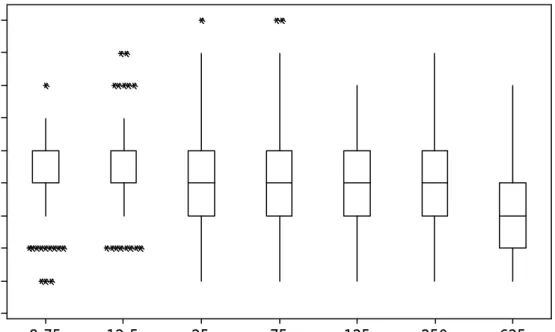
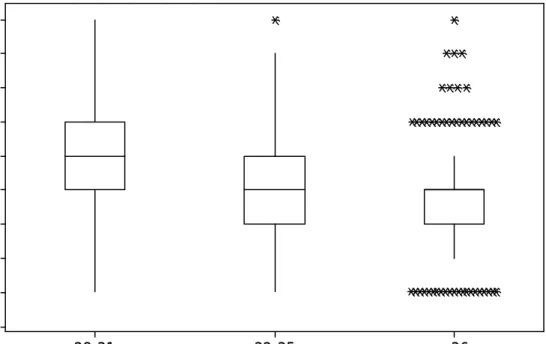
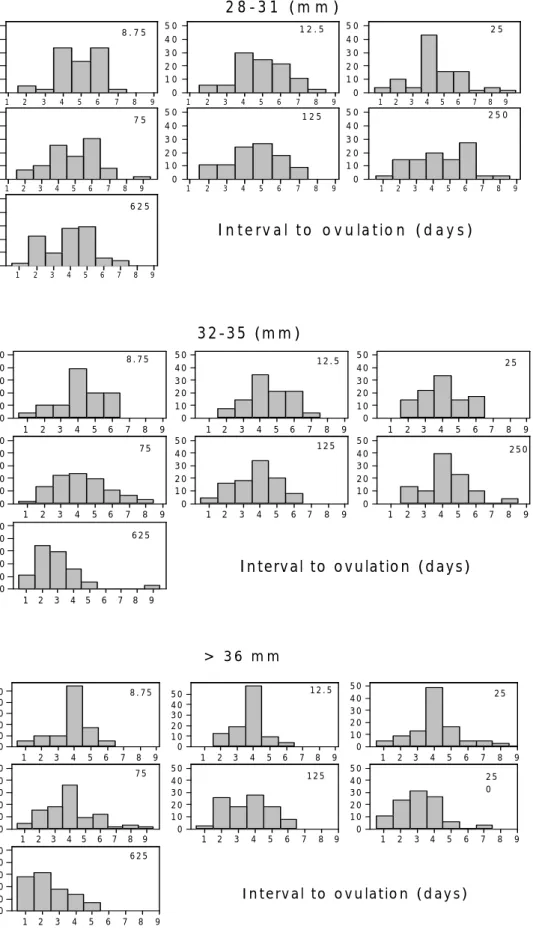
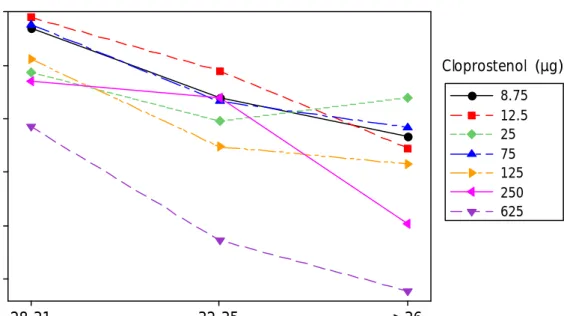
Documento similar
Abstract: Transepidermal water-loss (TEWL), stratum-corneum hydration (SCH), erythema, elas- ticity, pH and melanin, are parameters of the epidermal barrier function and
No obstante, como esta enfermedad afecta a cada persona de manera diferente, no todas las opciones de cuidado y tratamiento pueden ser apropiadas para cada individuo.. La forma
teriza por dos factores, que vienen a determinar la especial responsabilidad que incumbe al Tribunal de Justicia en esta materia: de un lado, la inexistencia, en el
The objective of the present study was to identify the effect of unmet dental treatment needs and socioe- conomic and sociodemographic variables on the patterns of
Further objectives of this study were to: (iii) examine the effects of either the prostanglandins or ovulation- inducing agents on the embryo recovery rate (ERR) and
In support that this may be a cause for the insulin signalling defects, the replenishment of cholesterol to the hippocampus of old mice reduced PI3K/Akt activity, prevented
The analysis of this ratio over the study period helps to understand the effect of meteorological and hydrological conditions on productivity, and the role of blue (abstracted)
On the other hand at Alalakh Level VII and at Mari, which are the sites in the Semitic world with the closest affinities to Minoan Crete, the language used was Old Babylonian,
